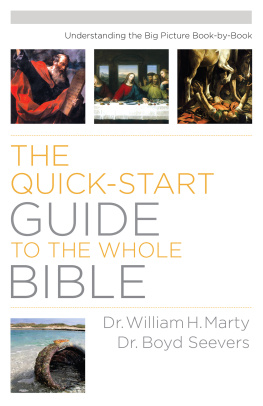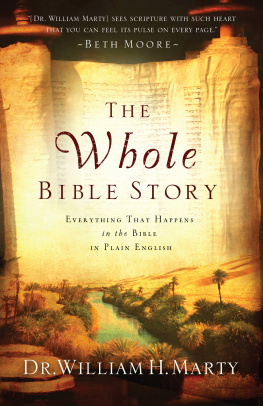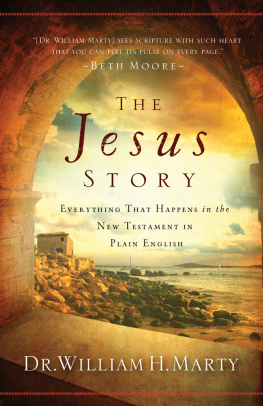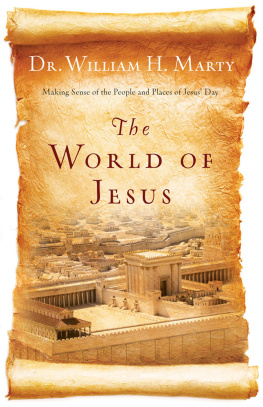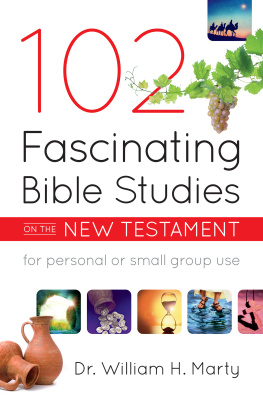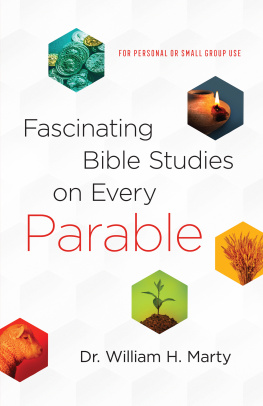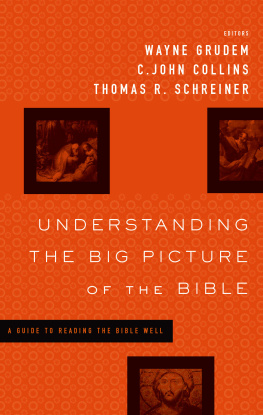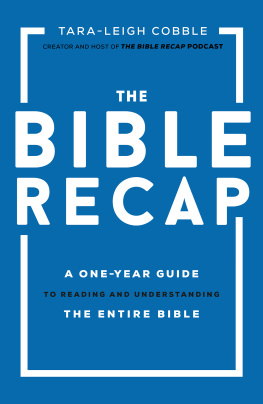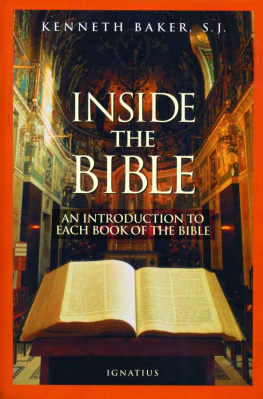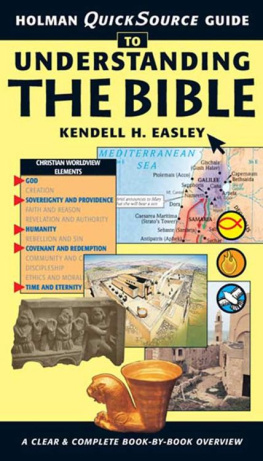2014 by William H. Marty and Boyd V. Seevers
Published by Bethany House Publishers
11400 Hampshire Avenue South
Bloomington, Minnesota 55438
www.bethanyhouse.com
Bethany House Publishers is a division of
Baker Publishing Group, Grand Rapids, Michigan
www.bakerpublishinggroup.com
Ebook edition created 2014
All rights reserved. No part of this publication may be reproduced, stored in a retrieval system, or transmitted in any form or by any meansfor example, electronic, photocopy, recordingwithout the prior written permission of the publisher. The only exception is brief quotations in printed reviews.
ISBN 978-1-4412-6400-8
Library of Congress Cataloging-in-Publication Data is on file at the Library of Congress, Washington, DC.
Unless otherwise noted, Scripture quotations are from the Holy Bible, New International Version. NIV. Copyright 1973, 1978, 1984, 2011 by Biblica, Inc. Used by permission of Zondervan. All rights reserved worldwide. www.zondervan.com
Scripture quotations marked ESV are from The Holy Bible, English Standard Version (ESV), copyright 2001 by Crossway, a publishing ministry of Good News Publishers. Used by permission. All rights reserved. ESV Text Edition: 2007
Cover design by Gearbox
Contents
Introduction
Is This Book for Me?
Perhaps youre a fairly new follower of Christ and would like some help with the big picture of whats really going on in the Bible. Or perhaps youve gone to church for many years but find that you still dont understand some books of the Bible very well. (Join the club!) Or perhaps you enjoy reading the Bible but dont own a collection of Bible reference books, and youd like a simple and affordable book that can help you understand whats in the Bible and what it means. If any of these circumstances describes you, then youre very likely to benefit from The Quick-Start Guide to the Whole Bible .
How Will This Book Help Me Better Understand the Bible?
The Quick-Start Guide to the Whole Bible was written by respected Bible professors who have been honored as outstanding teachers by their respective institutions for their ability to explain Gods Word. Dr. Boyd Seevers of University of NorthwesternSt. Paul wrote the Old Testament chapters, and Dr. William H. Marty of Moody Bible Institute wrote the New Testament chapters. Now theyre sharing their knowledge and insights, and in this book theyll take you through the Bible one book at a time to explain three aspects simply and clearly.
First, theyll help you understand whats important about the setting or background for each book. When we try to understand a book thats come to us from a time, place, and culture very different from our own, it usually helps to begin by familiarizing ourselves with the original situation. Thus, each chapter will begin by addressing questions like: Who wrote this book? To whom was he writing? What did he write? Where did the events occur? Why was he writing this material to these people?
Second, theyll summarize the content of each book as plainly and efficiently as possible. This will help answer the question What is this book of the Bible saying ?
Third, after looking at the background and summarizing the content, theyll explain each books significance. This should help answer the question What does this book mean ? In doing so, they will examine the books importance both for the original audience and also for believers like us today.
Old Testament
Dedication
This books Old Testament section is dedicated to the students at the University of NorthwesternSt. Paul who have filled the honors sections of Old Testament Survey. It is an ongoing pleasure to discuss with them the challenges of understanding and applying the Old Testament. The first half of this book is one of the fruits of those discussions.
Acknowledgments
The author of the Old Testament section wishes to thank the following:
My very capable and kind editor, Andy McGuire, as well as the rest of the friendly and professional staff at Bethany House. Working with them is a pleasure.
Friend and former student Sarah Schock, for her skilled work editing these chapters. Also my other student editors: David Detloff, Aubree Else, Kelsey Richards, Kristine Sollie, Christine Stevens, and Wade Weeldreyer, for their enthusiastic work and helpful suggestions.
Genesis
Setting
The book of Genesis does not name its author, but elsewhere (Exodus 17:14; Mark 7:10) the Bible implies that Moses at least wrote much of the first five books of the Old Testament (also known as the Pentateuch), including Genesis. Moses would have initially written these five books for the Israelites who had come out of Egypt with him.
In Genesis, Moses explains to these Israelites the origins of the world, of human beings, of sin, of the Israelite people and their first covenant with God. Whereas contemporary readers may look to the first part of Genesis for answers to questions that are important in modern thought (such as how and when the world began), Moses likely addressed questions more applicable to his original audience: How many gods are there? Is our God like the gods of the peoples around us? How should we relate to God? Genesis can best be understood as answering queries like these, although how it addresses them continues to tell believers throughout time what God is like and how we can walk with him.
Summary
The author begins with the creation story (Genesis 1:12:3), then divides the rest of the book into ten sections, each beginning with the phrase This is the account of or This is the written account of (2:4; 5:1, etc.). However, many readers today find it helpful to understand Genesis in two major parts: Primeval History (111), telling of the worlds earliest history, and then Patriarchal History (1250), which tells about the Israelite patriarchs Abraham, Isaac, and Jacob, and of Jacobs twelve sons.
Primeval History
In chapters 1 through 11, God creates and guides the whole world in order to bless it. This section includes events such as the creation, the fall of humanity, the flood in the time of Noah, and the Tower of Babel (e.g., see Matthew 24:37; Romans 5:14).
These earliest chapters also give rise to some of the most vexing questions that someone today might ask of the Bible: When did creation take place? Did God create everything in seven twenty-four-hour days? How could human lifespans have been so long prior to the flood? (e.g., Genesis 5:132). Who were the sons of God and the daughters of humans? (6:2). The original author and his audience probably knew the answers to such questions, but modern readers struggle to find the answers in the text.
The book begins with the story of creationa grand, beautifully crafted account of God taking a dark, chaotic void (1:2) and reshaping it into an orderly masterpiece filled with light and life. God then rests, symbolizing that his work is complete, an act the Israelites later were to emulate: One day of every week they would rest as a sign of their national covenant with him (Exodus 31:13).
The text then shifts in Genesis chapters 2 through 3 to a narrative of events in one part of creation, called the garden of Eden. God graciously gives to the first man food, work, and dominion over the animal realm. Despite his marvelous situation, the man God made is incomplete until God also creates the womanthe mans ideal counterpartand together they represent Gods perfect pattern for marriage.
Tragically, their wholeness is forever broken through the deception of the serpent, who entices them to disobey Gods clear command. God rightly judges all the guilty parties. He likewise graciously provides for the peoples immediate needs and for the continuation of human life, though because of the entrance of sin, all must face the specter of death.
Next page
